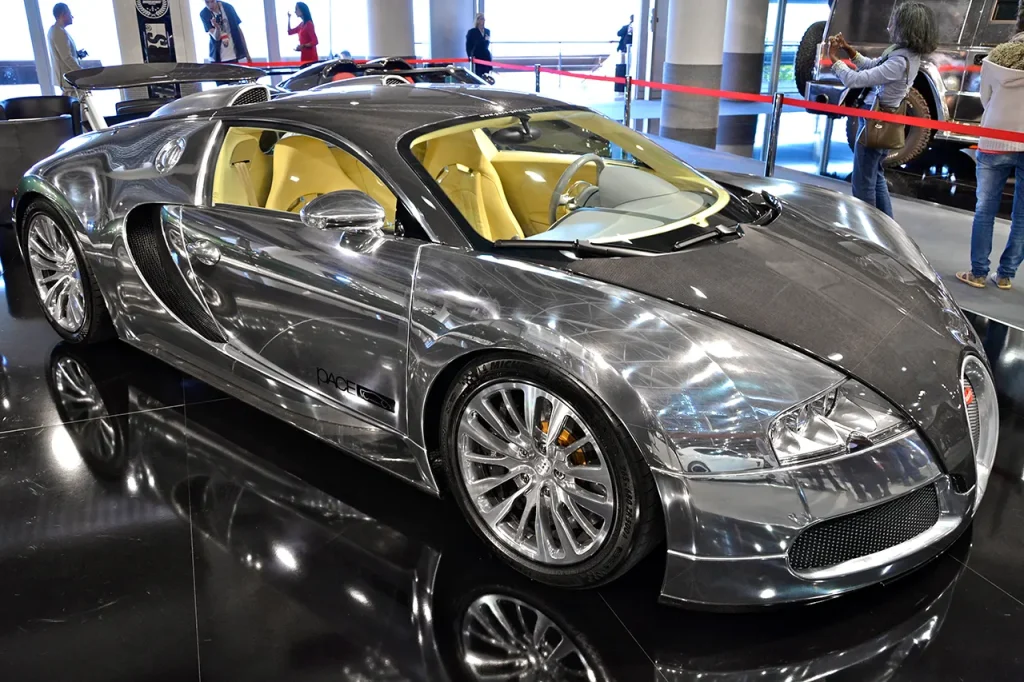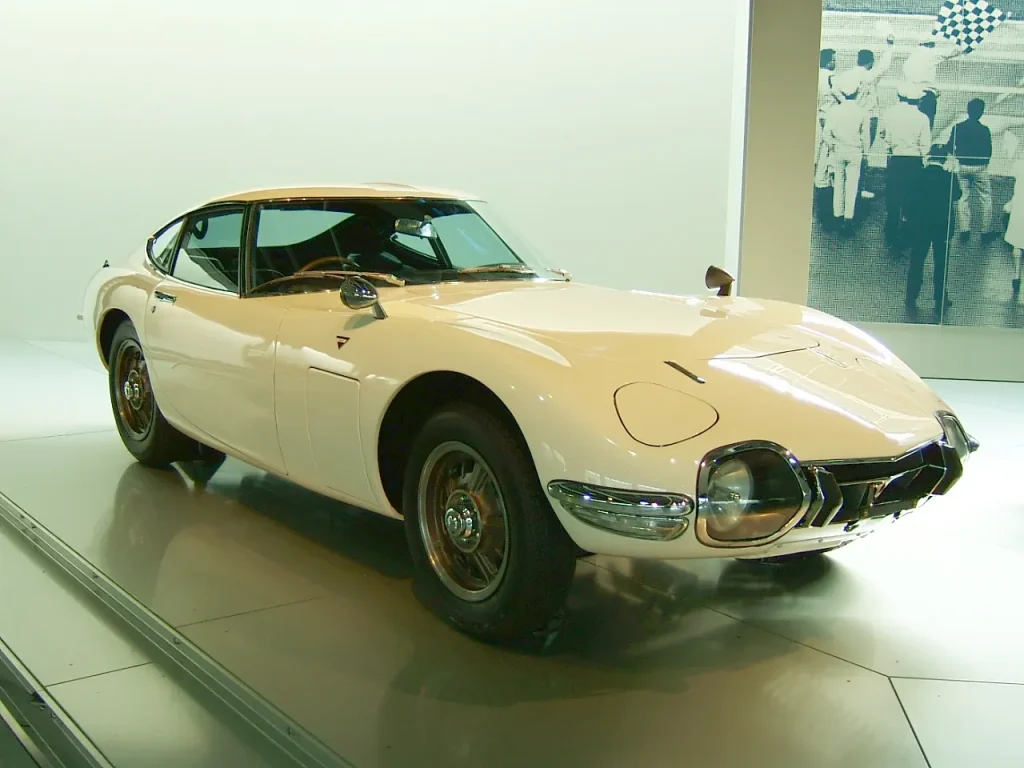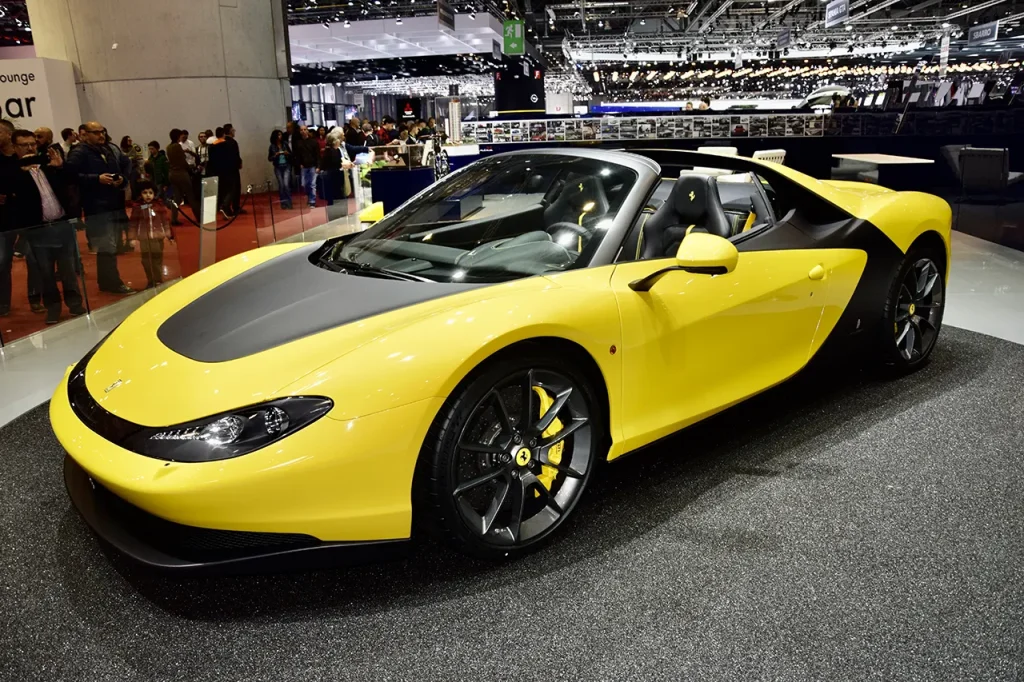Bugatti Veyron Pur Sang (2007) – A Testament to Pure Performance

Back when the Bugatti Veyron was first released in 2005, the car was a marvel of modern engineering. The car produced 1001 horsepower which propelled the car to 253 mph. Bugatti decided to push the envelope even further with the release of the ultra-exclusive ‘Pur Sang’ edition in 2007. ‘Pur Sang’ means ‘Pureblood’ in French, and aptly encapsulates the essence of this automotive masterpiece.
With a limited production run of only 5 units, the Bugatti Veyron Pur Sang flaunts an all-aluminium and carbon fibre body, losing about 100 kg compared to the original. The distinctive choice of materials also allows the Pur Sang to show off a unique two-tone aesthetic as the car presents an enticing mix of polished aluminium and raw carbon fibre.
The Pur Sang retains the formidable 8.0 litre quad-turbo W16 engine from the standard Veyron, giving the car an incredible 0-60 time of 2.5 seconds. Originally the Pur Sang sold for $1.4m, but the value has since skyrocketed making it one of the most extraordinary cars in the world.
Alfa Romeo 33 Stradale (1967-1969) – Italian Elegance Meets Racing Pedigree

The Alfa Romeo 33 Stradale was unveiled at the 1967 Turin Motor Show and captivated a blend of Italian style and racing pedigree. Stradale means ‘road-going’ in Italian and signifies the car’s duality as a track warrior and an extravagant road car. With a reported production run of 18 units, the 33 Stradale is one of Alfa Romeo’s rarest and most legendary models.
The car is now worth over $10m and is a testament to the peak of 1960s automotive design. The sleek, curvaceous body was penned by Franco Scaglione. Yet, the 33 Stradale was more than just a pretty face. The tubular chassis was borrowed from another Alfa Romeo – the Tipo 33 race car – and accommodated a mid-mounted 2.0 litre V8 engine that produced around 230 horsepower.
With a blend of seductive looks and spirited performance, the 33 Stradale has become coveted by collectors. There is rarely an opportunity to buy one, and when they do come up for sale, collectors will need to dip deeply into their pockets to pay the hefty 8-figure price tags they command. The Alfa Romeo 33 Stradale is a symbol of an era when racing tech met street style.
Customise your 3D number plates
Build unique number plates with our intuitive and fully interactive number plate builder.
Build Your 3D Number Plates
Mercedes-Benz CLK GTR (1998-1999) – A Supercar Legend

Born from the crucible of GT1 sports racing, the Mercedes-Benz CLK GTR is an exhibition of German automotive excellence. The CLK GTR was built between 1998 and 1999 and stands as one of the rarest cars Mercedes produced. The production run was for 25 coupes and 6 roadsters.
Mercedes prowess in seamlessly marrying track performance with road-going capability is symbolised fully in the CLK GTR. A 6.9 litre V12 engine is nestled behind the driver and generates 604 horsepower. This powerhouse could accelerate from 0-60 in 3.8 seconds and could reach a top speed of 214 mph.
The low-slung body, massive rear wing, and its broad, aggressive stance embody the car’s racing origins. But it wasn’t just for show – the CLK GTR clinched the FIA GT Championship in 1997, proving its worth on the track before it had even hit the road.
In today’s market, the car commands a price well into the 7-figure range. The car was born in a time where the lines between race cars and road cars were intentionally blurred and is an incredible and important part of automotive history.
Jaguar XJ220S (1994) – British Engineering at its Pinnacle

The XJ220S is the road legal version of the XJ220C race car and features a twin-turbo V6 engine that produces 680 horsepower. The car is elegant, refined, and powerful – a combination synonymous with the Jaguar brand. A top speed of 228 mph makes this car one of the fastest cars in the world even today.
Within the pantheon of rare and exotic cars, the XJ220S lives in a special place. Only 6 cars were made in 1994, setting this car apart as a sought-after icon of British automotive engineering.
Its evocative design, power, and rarity, makes this car a prized possession in any collection. The XJ220S is undoubtedly a jewel in the crown of the automotive landscape. As a modern classic, it continues to captivate enthusiasts worldwide with a seamless blend of scarcity, speed, and style.
Further Reading
You may also be interested in: The Ferrari KC23 – A Masterpiece of Design and Engineering?
Lamborghini Reventón (2008) – Italian Artistry Meets Fighter Jet

Inspired by the world’s fastest airplanes, the Lamborghini Reventón’s design was characterised by sharp, angular lines and a matte medium grey finish. The design echoes the exterior of a military fighter jet. The production run was limited to 21 coupes and 15 roadsters. This stunning machine exudes an air of exclusivity that few other cars can match.
In the heart of the Reventón lies a 6.5 litre V12 engine capable of accelerating the car to a blistering speed of 211 mph and achieving a 0-60 time of 3.3 seconds.
The Reventón’s rarity and unprecedented design make it an extraordinary find for any collector. Its aggressive stance and dramatic lines, as well as formidable performance, have immortalised the car as a coveted piece of Lamborghini’s illustrious history. It truly is a rare beauty that exemplifies the innovation and audacity of the iconic Italian manufacturer.
Porsche 911 GT1 Straßenversion (1996-1997) – The Le Mans Legend for the Street

A direct embodiment of the German automaker’s racing prowess, the incredibly rare Porsche 911 GT1 Straßenversion was brought from the racetracks of Le Mans to the public roads. It was manufactured between 1996 and 1997 and only 25 were ever produced.
The 911 GT1 Straßenversion was birthed from the necessity of homologation rules which required a certain number of road legal versions to be made of any race car. The street version maintains most of its race-bred DNA with a twin-turbocharged 3.2 litre engine that delivers 537 horsepower. The flat-6 can take the car to a top speed of 191 mph with a 0-60 time of just 3.7 seconds, a beast even by today’s standards.
The car’s design merges elements from the classic 911 silhouette with the Le Mans race version. The Straßenversion features gullwing doors and an elongated, aerodynamic body. With prices in the 8-figure range, this exclusive car remains a monument to Porsche’s success on the racing circuit and its dedication to bringing that adrenaline-filled experience to the streets.
Customise your 4D number plates
Build unique number plates with our intuitive and fully interactive number plate builder.
Build Your 4D Plates
Toyota 2000GT (1967-1970) – Japan’s First Super Car

In the realm of ultra-rare cars, few can match the allure of the Toyota 2000GT – Japan’s inaugural entry to the high-performance sports car market. The 2000GT was manufactured between 1967 and 1970 and heralded a new era for Japanese automakers, challenging European counterparts on their own turf.
The 2000GT was born from a collaboration between Toyota and Yamaha and shook the world with its sleek, aerodynamic design and high-performance capabilities. The production run was limited to 351 hand-built units, each featuring a 2.0 litre inline-6 engine delivering 150 horsepower. It was faster than comparable models from Porsche and Jaguar, with a top speed of 135 mph. The car gained worldwide recognition when a modified 2000GT starred in the 1967 James Bond Film You Only Live Twice, which secured its place in automotive (and cinematic) history.
Pagani Zonda Cinque (2009) – Limited Edition Italian Masterpiece

In 2009, the automotive world was blessed with the introduction of the Pagani Zonda Cinque – a road legal hypercar of unparalleled design and performance. Only 5 cars were made, hence the name ‘Cinque’ (five in Italian). The Cinque is among the rarest and most exclusive cars in existence.
The car was derived from the track-only Zonda R and, unsurprisingly, delivers the exhilarating performance of a race car tweaked to comply with road regulations. The Cinque houses a 7.3 litre V12 Mercedes engine that produces an immense 678 horsepower and 780 Nm of torque. Coupled with the lightweight design, the Cinque can accelerate from 0-60 in 3.4 seconds and can reach a top speed of 217 mph.
Pagani’s attention to detail and dedication to craftsmanship is exemplified in the design and construction of the Cinque. The intricate weave of its carbon fibre body, sculpted lines, and artisanal quality of its bespoke interior are all a testament to the beauty of the Zonda Cinque.
Ferrari Sergio (2015) – An Ultra-Limited Tribute

Few brands can compete with Ferrari when it comes to creating ultra-exclusive supercars. The 2015 Ferrari Sergio was built as a tribute to the late Sergio Pininfarina, who was an esteemed Italian car designer and patriarch of the Pininfarina design company. Only 6 cars were made, with each being offered by invitation to chosen Ferrari clients. The Ferrari Sergio remains one of the most rare and exclusive cars in the world.
It was developed on the chassis of the 458 Spider, but features a completely new body that is more aggressive and aerodynamic in its design. The 4.5 litre V8 engine produces 605 horsepower, taking the car from 0-60 in under 3 seconds and delivering a top speed of over 200 mph. The concept version of the car has an open-top barchetta design, no windshield, and a unique roll-bar design. Both driver and passenger are provided with matching helmets.
The exterior of the Ferrari Sergio is a striking homage to the company’s racing roots, but the interior doesn’t disappoint either. Ferrari’s luxury standards are on full display – the interior hosts a plethora of high-quality materials and finishes – from its exquisite Poltrona Frau leather upholstery to its sporty carbon fibre details. The cabin offers a blend of performance and luxury. Beyond the exceptional performance, the Sergio’s rarity and lineage make it a high coveted car. The cars originally sold for a reported $3m each.
Aston Martin One-77 (2009-2012) – The Pinnacle of Aston Martin

Aston Martin has long been synonymous with sophistication, style, and speed. With the introduction of the One-77 between 2009 and 2012, Aston Martin took this reputation to new heights. The One-77 has been described as intense and exhilarating. It was limited to 77 vehicles’ globally, instantly making it one of the rarest Aston Martin models.
The car was built around a full carbon fibre monocoque chassis and powered by a naturally aspirated 7.3 litre V12 engine. The One-77 produces an incredible 750 horsepower. This powerplant is paired with a 6-speed automated manual transmission and a carbon fibre driveshaft, which allows the car to sprint from 0-60 in 3.5 seconds and reach a top speed of 220 mph. The performance credentials beautifully match its evocative design, which represents a harmony of form and function.
Inside the car you’ll see an exclusive mix of fine leathers, aluminium, and carbon fibre – all hand-finished by Aston Martin’s team of artisans. The sporty cabin reflects Aston Martin’s commitment to luxury and driving pleasure. The One-77 also introduced a variety of more advanced technologies that would later filter down to other models in the Aston Martin range. The One-77 stands proud as a celebration of Aston Martin’s commitment to creating the ultimate grand tourer.
Further Reading
You may also be interested in: Aston Martin Valour: A Tribute to 110 Years of Automotive Excellence


